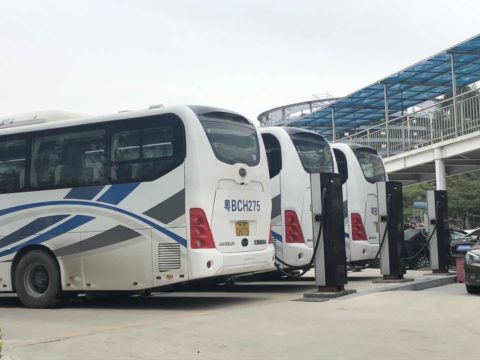
If you want to be inspired about the future of electric vehicles (EVs), check out what’s happening in China. With the world’s largest vehicle market, China comprised more than half of all EV sales last year. The Chinese bought more EVs in a single year than Americans bought cumulatively over the past 10 years. And China is eyeing an even bigger transformation: I was in the country recently for an international symposium on moving to 100 percent electric transportation.
Our first stop was Shenzhen, one of the four leading EV cities in China. At the airport, I stepped into an all-electric taxicab produced by BYD, China’s biggest EV manufacturer. The car is the size of a small SUV, with a quiet ride and excellent acceleration. I thought about my last trip to Los Angeles, where I tried—unsuccessfully—to rent an electric car. Los Angeles has a lot to learn from Shenzhen in making EVs easily accessible. The next day, I was greeted by a beautiful blue sky. That’s because Shenzhen has taken aggressive actions to clean its air. I met up with colleagues Anand Gopal from the William and Flora Hewlett Foundation, Anthony Eggert from ClimateWorks Foundation, Huiming Gong from Energy Foundation China (EF China), and the rest of the EF China transportation team to learn how Shenzhen has accomplished this.
Shenzhen is a shining model for other rapidly developing cities for how to grow the economy while cleaning the air. In less than a decade, GDP more than doubled, fine particle pollution was cut by 70 percent, and Shenzhen achieved the European Union standards for air quality. Through a combination of strong national and city policies, the city converted its entire bus fleet (16,000) and most of its taxis (21,000) to electric. There are more electric buses and taxis in Shenzhen than in the entire U.S. Shenzhen also has more than 40,000 electric trucks, including garbage trucks and delivery vehicles, with the goal of electrifying all trucks by 2030.
China’s success in electrifying transportation—along with other measures, such as transitioning from coal to clean energy—will have direct consequences for the health of its population.
Our next stop was Beijing, where we met with officials from Didi, the world’s leading ride-sharing company. Think Lyft and Uber, only Didi is bigger than those two companies combined. Didi’s operations director told us that about a quarter of all China’s EVs are on their platform, and that their goal is to have 1 million EVs by 2020, which is the total number of EVs in the entire U.S. today. In 2018, Didi initiated an effort to promote EVs, including working with vehicle manufacturers to produce EVs tailor-made for ride hailing. Didi even started its own charging company, Orange Energy, with a plan to use the ride-hailing app to tell drivers when and where to charge their EVs.
Now for the main event: The “Zero Emission and All Electric Vehicles Summit.” The summit was located in the Diaoyutai State Guest House, where major state events are held to welcome other countries’ presidents and premiers. This used to be the garden of the King of the Qing Dynasty, and the landscape is spectacular, with winding pathways hugging a half-frozen river. Along the way we encounter the EV showcase, where manufacturers are displaying both current and prototype models. There are many manufacturers competing with Tesla for the premier luxury EV, including startups like NIO and Enovate.
The event was co-organized by EF China and the International Council for Clean Transportation, and co-hosted by various California agencies. It was a global affair, with keynote speeches by government representatives from India, Norway, Britain, the Netherlands, and the nation-state of California. For many years, California led the world on zero emission vehicle policy, and if the state were its own country, it would have the 5th largest economy in the world. But it’s clear that other nations have pulled ahead, with more aggressive policies and goals to fully electrify transport. Now the question is: Will California rise to the challenge and pass even more aggressive policies in the race to zero emission transportation?

The Chairman of BYD, Wang Chuanfu, is bullish on the prospect of fully electrifying China’s transportation by 2030. He predicts that heavy-duty vehicles will electrify faster than passenger vehicles, and that in just three years (by 2022), major cities could achieve full electrification of their new vehicle sales. BYD produces both conventional and electric vehicles, but the company is banking on the latter for its future sales. They produce cars, garbage trucks, delivery vehicles and even big rig trucks in electric drive. The EV commitments by Ford and General Motors fall short compared with BYD and other Chinese manufacturers.
EF China President Zou Ji highlighted the policies that are driving China’s transition to electric mobility. A bedrock policy is the Zero Emission Vehicle policy, modeled after a long-standing California regulation. China’s policy requires that up to 12 percent of sales must be EVs by 2020 (up from about 4 percent in 2018), but because of credits from early compliance, the actual share of EVs required is much smaller. Still, China is on track to exceed the requirements of the policy because of fiscal incentives and aggressive city-level policies such as fossil-free zones and restricting new vehicle licenses to EVs only. These policies are helping to drive down the costs of batteries, putting EVs on course to be cheaper than conventional cars within the next five years.
As we left the summit, the air quality index plummeted. We walked through a fog of soot on our way to the subway station. My throat tightened as the pollution exposure caused me to lose my voice, reminding me that China’s success in electrifying transportation—along with other measures, such as transitioning from coal to clean energy—will have direct consequences for the health of its population. I returned to our San Francisco office more optimistic that an EV future is within our reach, and am even more motivated to leverage China’s leadership to support California and other states in the race to zero emission transportation.
Energy Foundation launched EF China in 1999. As of 2019, the two operate as individual and separate charitable organizations.